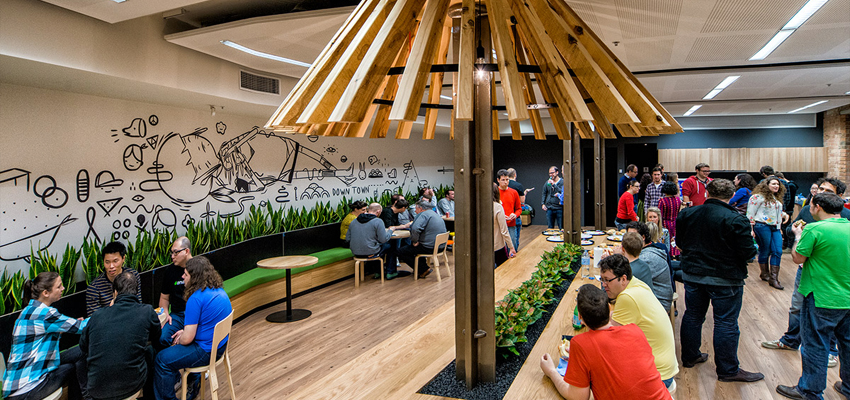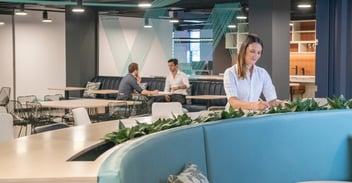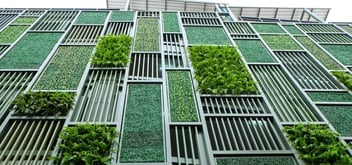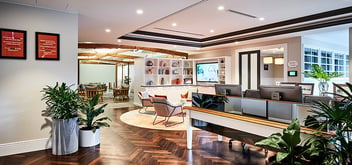Working green is the new normal. If your workplace needs an environmentally friendly overhaul, this guide breaks down the definition of a green/sustainable building, how an organisation can reduce it’s office eco-footprint, and the benefits of a sustainable workplace, including energy expenditure and increased productivity.
What is a green workplace?
According to the Green Building Council of Australia: “Green Buildings incorporate design, construction and operational practices that significantly reduce or eliminate its negative impact on the environment and its occupants”.
The aim of a Green Building is to reduce the overall environmental impact or ecological footprint of a building or office, during construction and over the life of the building through ‘built-in’ sustainability.
Building green is an opportunity to use resources efficiently while creating healthier environments for people to live and work in. Examples of building green include:
- Reducing the use of material resources, waste & environmental degradation
- Reducing pollution of air, earth and water in material sourcing & manufacturing, during construction and over the life cycle of the building
- Reducing damage to natural systems & bio-diversity
- Efficient energy, water & resources
- Providing high quality & healthy productive spaces, utilising elements such as natural light and responsive heating/cooling measures
These can all be linked to the principles of sustainable development which a green or sustainable building should reflect: environmental protection, economic development and social development.
How to reduce your office environmental footprint
Reducing your environmental footprint helps you waste less energy, reduce operational expenditure, and invest in your people.
Here are pro-active things you can do:
Reduce the amount of energy & water usage in your office
- Use sensors to control lights in low use areas & timers for after office hours
- Utilise energy efficient light bulbs
- Utilise natural light/daylighting to its full potential where possible in your office
- Use recycled water for bathrooms
- Look into rainwater storage options on your building
- Encourage water saving practices in common areas of your workplace, e.g. kitchens
Minimise waste during construction & building operations
- Incorporate recycled and/or responsibly produced materials into your building/office design (check ethical production registers for provenance)
- Only order the necessary amount of material & responsibly dispose of any excess
- Consider the heating & cooling of your office space during construction
- Use sufficient insulation to reduce the need for artificial temperature controls thus reducing energy costs
- Increase natural ventilation when building your office space through consideration of window placement, etc.
Use green power
- Research the possibility of creating onsite generation of renewable energy sources such as solar & wind power
- Design for disassembly & material re-use
- Consider the future of the products and materials you are using and how they may be reused in your office space as time goes on
Utilise furnishing & fittings with non-toxic off-gassing
- Off-gassing is the release of a gas that was trapped, dissolved or absorbed in some material. There are concerns that in closed environments some industrial products can produce gases that may be harmful to human health.
- Be sure to research the origins and make-up of your materials to ensure a healthy atmosphere in your workplace
Consider parking & transport to your office location
- Aim to promote use of public transport if choosing a new office location
- Offer storage facilities to encourage use of other modes of transport, e.g. bicycle racks
Benefits of a sustainable workplace
The ROI of going green is now well established. Buildings and offices are seeing measurable benefits across a range of areas, including reduced expenditure, workforce productivity and staff engagement.
Recent studies have shown that green workplaces:
- Reduce the average sick days per employee
- Reduce sick leave costs
- Improved productivity
- Increase job satisfaction
- Talent retention
Some research suggests that as many as 91% of millennials would switch to use a company or brand based on its commitment to social good and investment in things like sustainability. With this pillar so vital to an organisation’s success, it pays to engineer your business environment in a way that’s good for both the planet, and your bottom line.
As well as providing a more sustainable office, smart workplace design can also create spaces that promote wellness and wellbeing at work. Learn more in our eBook: The fundamental of wellness and wellbeing in workplace design.






